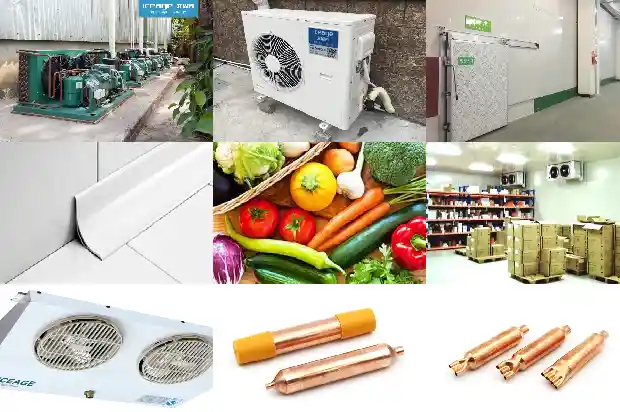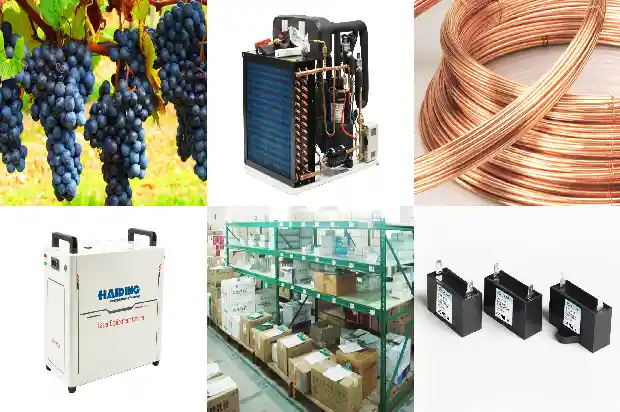The Use and Common Maintenance Methods of Refrigeration Compressors
2025-03-05
- Visual Inspection of the Compressor Capacitor
If the capacitor's casing is found to be deformed, bulging, cracked, or leaking liquid, it indicates that the capacitor is damaged and cannot be used anymore. When replacing the capacitor, it is advisable to use the original specification and model as much as possible, and do not replace it randomly.
The capacity of the capacitor will decay due to the harsh usage environment and the passage of time. Generally, when the decay amount is greater than 20%, phenomena such as difficult starting, large starting current, and long starting time will occur. Especially when the power supply voltage is 20% lower than normal, the compressor may experience starting tripping, overcurrent protection, and even burnout. Therefore, when phenomena such as difficult starting, overly long starting time, and instant tripping occur, the capacitor should be checked first. - Discrimination of Compressor Terminal Posts and Detection of Winding DC Resistance
Although the positions of the terminal posts of compressors from different manufacturers are different, each terminal post is marked with a letter beside it. For a single-phase compressor, C represents the common terminal, R represents the main winding terminal, and S represents the auxiliary winding terminal. The wiring of each winding must be carried out according to the method shown in the diagram; otherwise, the compressor will not work properly and may even be burned out.
The determination method for the common terminal C, main winding terminal R, and auxiliary winding terminal S of a single-phase compressor:
Based on the principle that the wire diameters and turns of the main and auxiliary windings of a single-phase compressor are different, and thus their DC resistance values are also different (the resistance value of the main winding C~R is smaller, the resistance value of the auxiliary winding C~S is slightly larger, and the resistance value of R~S is the sum of the resistance values of the main and auxiliary windings), use the resistance gear of a multimeter.
Assume that any terminal post is the C terminal. Touch one probe of the multimeter with the assumed common terminal, and touch the other probe with the other two terminals respectively to measure the resistance value.
If the assumption is correct, then the other terminal with a smaller resistance value is the main winding terminal R, and the other terminal with a slightly larger resistance value is the auxiliary winding terminal S. Using the same method, the common terminal C, main winding terminal R, and auxiliary winding terminal S can be found after at most three assumptions. - Wiring Method and Approximate Resistance Value of a Three-phase Compressor:
Although the positions of the terminal posts of three-phase compressors from different manufacturers are different, each terminal post is marked with the letters U, V, and W beside it. After being identified by the phase sequence protector, phase A corresponds to U; phase B corresponds to V; phase C corresponds to W.
In addition, the wiring can also be carried out according to the color correspondence of the compressor windings, that is: red represents phase A connected to terminal U; white represents phase B connected to terminal V; blue represents phase C connected to terminal W. The wiring of each winding must be carried out according to the method shown in the diagram; otherwise, the compressor will rotate in reverse.
Since the wire diameters and turns of the three windings of a three-phase compressor are the same, their DC resistance values are also the same (the same applies to frequency conversion compressors). For example, if the resistance value measured for one winding of a certain three-phase compressor is equal to 2.2 ohms, the resistance values of the other two windings must be equal to 2.2 ohms respectively, that is, U~V = V~W = W~U = 2.2 ohms. - Measurement of Compressor Insulation Resistance:
Before leaving the factory, the insulation resistance value between the compressor terminals and the casing of a refrigeration compressor should be greater than 2 megohms, which is the requirement for the air conditioner before leaving the factory. In fact, due to the harsh operating environment of the air conditioner, this standard cannot be used to judge the insulation quality after the air conditioner has been running for a period of time.
Generally, if it is not less than 1 megohm, it is considered normal. However, the value of 1 megohm is measured with a 500V insulation resistance tester. It is absolutely not allowed to use a multimeter to measure the insulation resistance, because the internal power supply voltage of the multimeter is only 9V, and the measured insulation resistance value is meaningless. - Maintenance of the Compressor Protector
The compressor will protect itself when it is overloaded or overheated. There are two types of protection devices: built-in and external. Here, only the external type is described. If the compressor cannot start automatically within 3 minutes after the protection occurs, it indicates that the protector has been activated.
After the protection occurs, due to the relatively high temperature of the compressor body and slow heat dissipation, the reset time of the protector is relatively long, generally 3 to 15 minutes, and it can be up to 30 minutes at most. If it still cannot start after 30 minutes, it is possible that the overload and overheat protector has been damaged. - Safety Precautions for Compressor Maintenance
Oxygen is colorless, odorless, non-toxic, and non-combustible, and it has no explosiveness by itself. However, when mixed with other combustible or explosive gases, it will support combustion or cause an explosion. Especially, it can have a violent chemical reaction with oils and explode instantly. Since there is lubricating oil in the compressor, it is absolutely prohibited to blow the system with oxygen, and the oxygen cylinder should be kept away from the compressor maintenance site. Otherwise, it will cause serious consequences such as the explosion of the compressor and even the simultaneous explosion of the system. - Handling of Difficult Starting and Shaft Seizure (Cylinder Locking) of the Compressor
Difficult starting and shaft seizure are two completely different fault phenomena, and they must be treated differently.
When the capacity of the compressor capacitor decays to 60% of the original value, when the outdoor ambient temperature is lower than minus 5 degrees Celsius, when the power supply voltage is 15% lower than normal, and when the system pressure has not been balanced yet, these factors will all cause difficult starting of the compressor.
In fact, shaft seizure and cylinder locking mean the same thing, which belongs to compressor faults or the compressor has been damaged. The main cause of cylinder locking is the dirtiness of the system or lack of oil. Generally, the cylinder body and valve plates will be damaged to varying degrees. In principle, it cannot be repaired or is beyond repair, and a new compressor needs to be replaced. However, there are many experiences in handling cylinder locking. For some compressors with less serious cylinder locking, they can be saved by means of knocking, increasing the capacitance, etc. - Judging the Short Circuit of the Compressor Motor Winding
Use a multimeter to measure the resistance value between two points, C-R or C-S, of the compressor motor winding. If the measured resistance value of the winding is smaller than the normal value, it can be judged that this winding is short-circuited.
For a three-phase motor, touch the two probes of the multimeter with 2 of the 3 terminal post terminals respectively. If the resistance values measured three times are the same, it indicates that the winding is in good condition; if the resistance values measured twice are infinite, it indicates that one group of windings is open-circuited; if the resistance values measured three times are all infinite, it indicates that at least two groups of windings are open-circuited; if the resistance values measured twice in the three measurements are significantly smaller than the value measured in the other time, it indicates that there is a short circuit.
Related Articles
- Brief Analysis of Commonly Used Automatic Control Devices in the Refrigeration System
- Common Fault Causes and Solutions of Cold Storage Systems
- Pipelines Used in the Refrigeration System
- How Do You Remove Mildew from the Cold Storage? Have You Used These Methods?
- Common Fault Causes of Totally Enclosed Refrigeration Compressors
- Cause Analysis of High Discharge Temperature and Overload Protection of Modular Units
- Analysis of the Causes and Hazards of Corrosion in the Circulating Water System
- Common Fault Causes and Replacement of Multi-connected Unit Compressors
- What Causes the Indoor Unit of an Air - conditioner to Freeze? Here's the Answer~
- Controlled Atmosphere Fresh - keeping Warehouse
- Analysis of Causes for Compressor Liquid Hammer, Overheating and Pre - heating
- Causes and Solutions of Ice Blockage, Dirt Blockage and Oil Blockage
- Prefabricated Controlled Atmosphere Warehouse - Prolonging the Fresh - keeping Period of Fruits and Vegetables
- What Are the Common Causes of High - pressure Faults in Chillers?
- What Are the Common Causes of Cold Air Blower Noise?
- Four Combustible and Explosive Refrigerants: Precautions When in Use!
- Welding Equipment Used in Refrigeration System Maintenance
- Air - conditioner Low - pressure Alarm? These Nine Common Causes
